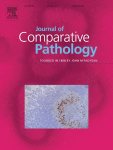Ver ítem
- xmlui.general.dspace_homeCentros Regionales y EEAsCentro Regional Buenos Aires SurEEA BalcarceArtículos científicosxmlui.ArtifactBrowser.ItemViewer.trail
- Inicio
- Centros Regionales y EEAs
- Centro Regional Buenos Aires Sur
- EEA Balcarce
- Artículos científicos
- Ver ítem
A descriptive Study of lectin histochemistry of the placenta in cattle following inoculation of Neospora caninum.
Resumen
The aim of this study was to describe the lectin-binding pattern in the placentas of cows infected experimentally with Neospora caninum. Four cows were inoculated intravenously with 1 × 108 tachyzoites of the NC-1 strain of N. caninum at 150 ± 7 days of pregnancy. Two control cows were administered a placebo. An indirect fluorescence antibody test (IFAT) was performed on serum samples obtained before and after the inoculation. The cows were killed at 30
[ver mas...]
The aim of this study was to describe the lectin-binding pattern in the placentas of cows infected experimentally with Neospora caninum. Four cows were inoculated intravenously with 1 × 108 tachyzoites of the NC-1 strain of N. caninum at 150 ± 7 days of pregnancy. Two control cows were administered a placebo. An indirect fluorescence antibody test (IFAT) was performed on serum samples obtained before and after the inoculation. The cows were killed at 30 and 37 days post inoculation. Samples of placenta were taken for histopathology and lectin histochemistry. Fetal tissues and fluids were collected for histopathology and IFAT, respectively. All infected cows had high antibody titres. All fetuses had characteristic histopathological lesions, including non-suppurative meningoencephalitis, myocarditis, hepatitis and myositis, suggesting N. caninum infection. Only two infected fetuses developed specific antibodies. Mild non-suppurative inflammatory infiltrates were recorded in the placentae. Differences in the lectin-binding pattern were observed between infected animals and controls in the glycocalyx (CON-A and WGA) and apical cytoplasm (RCA-I and CON-A) of the trophoblastic cells; giant trophoblastic cells (CON-A and DBA); glycocalyx (PNA, WGA) and apical cytoplasm (CON-A, WGA, PNA, DBA and RCA-I) of endometrial cells; trophoblast of the interplacentomal region (WGA); endothelium (CON-A, SBA, RCA-1 and WGA); and finally, mesenchyme (CON-A, RCA-1, SBA, PNA and DBA). These findings indicate that there is a distinctive pattern of lectin binding in the placenta of cattle infected with N. caninum. The direct effect of the presence of the protozoa as well as the altered expression of cytokines could explain these changes in the maternofetal interface.
[Cerrar]

Autor
Dorsch, Matías A.;
de Yaniz, María Guadalupe;
Fiorani, Franco;
Hecker, Yanina Paola;
Odeon, Anselmo Carlos;
Morrell, Eleonora Lidia;
Campero, Carlos Manuel;
Barbeito, Claudio Gustavo;
Moore, Prando Dadin;
Fuente
Journal of Comparative Pathology 166 : 45-53 (January 2019)
Fecha
2019-01
Editorial
Elsevier
ISSN
0021-9975
Formato
pdf
Tipo de documento
artículo
Palabras Claves
Derechos de acceso
Restringido
 Excepto donde se diga explicitamente, este item se publica bajo la siguiente descripción: Creative Commons Attribution-NonCommercial-ShareAlike 2.5 Unported (CC BY-NC-SA 2.5)
Excepto donde se diga explicitamente, este item se publica bajo la siguiente descripción: Creative Commons Attribution-NonCommercial-ShareAlike 2.5 Unported (CC BY-NC-SA 2.5)

